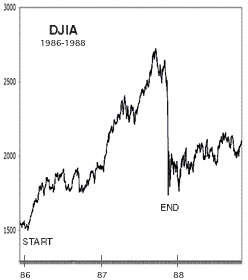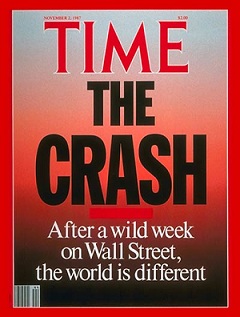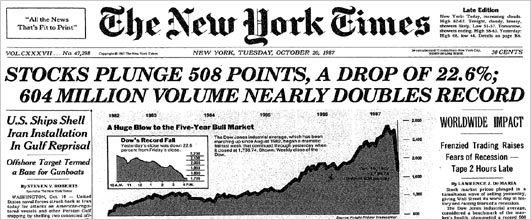By Jesse Colombo (This article was written on August 3rd, 2012)
The Stock Market Crash of 1987 or "Black Monday" was the largest one-day market crash in history. The Dow lost 22.6% of its value or $500 billion dollars on October 19th 1987.
 1986 and 1987 were banner years for the stock market. These years were an extension of an extremely powerful bull market that had started in the summer of 1982. This bull market had been fueled by low interest rates, hostile takeovers, leveraged buyouts and merger mania. Many companies were scrambling to raise capital to buy each other out. The business philosophy of the time was that companies could grow exponentially simply by constantly acquiring other companies. In a leveraged buyout, a company would raise a massive amount of capital by selling junk bonds to the public. Junk bonds are bonds that pay high interest rates due to their high risk of default. The capital raised through selling junk bonds would go toward the purchase of the desired company. IPOs were also becoming a commonplace driver of market excitement. An IPO or Initial Public Offering is when a company issues stock to the public for the first time. “Microcomputers” now known as personal computers were become a fast growing industry. People started to view the personal computer as a revolutionary tool that would change our way of life, while creating wonderful business opportunities. The investing public eventually became caught up in a contagious euphoria that was similar to that of any other historic bubble and market crash. This euphoria made investors, as usual, believe that the stock market would “always go up.”
1986 and 1987 were banner years for the stock market. These years were an extension of an extremely powerful bull market that had started in the summer of 1982. This bull market had been fueled by low interest rates, hostile takeovers, leveraged buyouts and merger mania. Many companies were scrambling to raise capital to buy each other out. The business philosophy of the time was that companies could grow exponentially simply by constantly acquiring other companies. In a leveraged buyout, a company would raise a massive amount of capital by selling junk bonds to the public. Junk bonds are bonds that pay high interest rates due to their high risk of default. The capital raised through selling junk bonds would go toward the purchase of the desired company. IPOs were also becoming a commonplace driver of market excitement. An IPO or Initial Public Offering is when a company issues stock to the public for the first time. “Microcomputers” now known as personal computers were become a fast growing industry. People started to view the personal computer as a revolutionary tool that would change our way of life, while creating wonderful business opportunities. The investing public eventually became caught up in a contagious euphoria that was similar to that of any other historic bubble and market crash. This euphoria made investors, as usual, believe that the stock market would “always go up.”
During this growth boom, the SEC found it increasingly difficult to prevent shady IPOs and conglomerates from proliferating. In early 1987, the SEC conducted numerous investigations of illegal insider trading, which created a wary stance among many investors. At the same time, inflation and overheating became a concern due to the high rate of economic and credit growth. The Federal Reserve rapidly raised short term interest rates to temper inflation, which dampened some of stock investors’ enthusiasm. Many institutional trading firms began to utilize portfolio insurance to protect against further stock dips. Portfolio insurance is a hedging strategy that uses stock index futures to cushion equity portfolios against broad stock market declines. As interest rates rose, many institutional money managers scrambled to hedge their portfolios at the same time. On October 19th 1987, the stock index futures market was flooded with billions of dollars worth of sell orders within minutes, causing both the futures and stock markets to crash. In addition, many common stock investors attempted to sell simultaneously, which completely overwhelmed the stock market.
On October 19th 1987, $500 billion in market capitalization was evaporated from the Dow Jones stock index. Markets in nearly every country around the world plunged in a similar fashion. When individual investors heard that a massive stock market crash was occurring, they rushed to call their brokers to sell their stocks. This was unsuccessful because each broker had many clients. Many people lost millions of dollars instantly. There are stories of some unstable individuals who had lost large amounts of money who went to their broker’s office with a gun and started shooting. A few brokers were killed despite the fact  that they had no control over the market action. The majority of investors who were selling did not even know why they were selling except for the fact that “everyone else was selling.” This emotionally-charged behavior is one of the main reasons that the stock market crashed so dramatically. After the October 19th plunge, many futures and stock exchanges were shut down for a day.
that they had no control over the market action. The majority of investors who were selling did not even know why they were selling except for the fact that “everyone else was selling.” This emotionally-charged behavior is one of the main reasons that the stock market crashed so dramatically. After the October 19th plunge, many futures and stock exchanges were shut down for a day.
Shortly after the crash, the Federal Reserve decided to intervene to prevent an even greater crisis. Short-term interest rates were instantly lowered to prevent a recession and banking crisis. Remarkably, the markets recovered fairly quickly from the worst one day stock market crash. Unlike after the stock market crash of 1929, the stock market quickly embarked on a bull run after the October crash. The post-crash bull market was driven by companies that bought back their stocks that that the considered to be undervalued after the market meltdown. Another reason why stocks continued to rise after the crash was that the Japanese economy and stock market was embarking on its own massive bull market, which helped to pull the U.S. stock market to previously-unforeseen heights. After the 1987 stock market crash, as system of circuit breakers were put into place to electronically halt stocks from trading if they plummet too quickly.
Other Stock Market Crash of 1987 Resources:
Wikipedia: Black Monday (1987)
What Caused the Stock Market Crash of 1987?
U.S. Federal Reserve: A Brief History of the 1987 Stock Market Crash (PDF)
Remembering the Stock Market Crash of 1987


